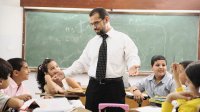The Untapped SEL Tool: Conflict
Here’s how you can use disciplinary moments to practice social and emotional learning.
Your content has been saved!
Go to My Saved Content.As educators, we know that every day in the classroom is full of teachable moments—unplanned opportunities that present an ideal chance to deepen student understanding. A child sharing a story about a family trip could be a teachable moment for literature or geography. An event in the news that has students talking could be a teachable moment for social studies.
The trick, of course, is being open to the moments presented. Sometimes we feel thrown by unplanned moments and avoid them. Sometimes we feel threatened by questions that we didn’t anticipate and ignore them. But if we challenge ourselves to stay curious about student thinking, even if it catches us off guard, we can experience some wonderful learning moments with our students.
We often miss some of the most powerful teachable moments in our classrooms: conflicts. Traditionally, educators have treated conflicts not as teachable moments but as disciplinary ones, and some conflicts do require disciplinary action. But many conflicts can lead to deeper social and emotional understanding for the students involved, and for the classroom community as a whole.
Of course, taking advantage of these SEL teachable moments can be both exciting and daunting. Often, we’re at a loss about how to shift student thinking in the moment of conflict. After all, children in conflict, just like adults in conflict, can be quite angry and resistant. And we ourselves may be triggered by the conflict, leaving us less prepared to facilitate an SEL teachable moment for the students.
Establishing Regular SEL Practice
If we set aside a regular time each week to teach social and emotional skills, we’ll be setting ourselves up to be able to draw on these skills in times of crisis. Regular SEL lessons allow students a time to practice these skills outside of actual moments of conflict. They allow teachers a chance to offer students feedback on their skill practice. And they allow everyone to develop a common language and understanding. A dedicated class period once a week in which students learn skills like self-talk, deep breathing, “I feel” and “I need” statements, boundary setting, and assertiveness techniques will go a long way in helping teachers and students actively transform moments of conflict into SEL teachable moments.
Reflecting on Discipline Styles
Most of us have a mix of proactive and reactive responses to unwanted behavior. It’s helpful to ask ourselves which response we favor. Are we more likely to be proactive—that is, to head off unwanted behavior by thinking about challenges and addressing them ahead of time? Or do we tend to react to unwanted behavior after it has happened? If we want to transform moments of conflict in class from disciplinary moments into SEL teachable moments, it will help if we can adopt a more proactive approach.
Anticipating SEL Teachable Moments
If we reflect on our daily work, we’ll probably be able to identify persistent conflicts in our classrooms. One student might have a habit of interrupting her peers and the teacher. Another might consistently forget directions, distracting his peers. We could devise proactive interventions to transform these instances into SEL teachable moments. For instance, the student who interrupts may be asked to take five deep breaths whenever she has the impulse to interrupt. And the one who forgets directions could be asked to write them on chart paper for the whole class as the teacher delivers them. If we plan for conflict, we will have greater success in transforming disciplinary moments into SEL teachable moments.
Allowing for Independent SEL Skill Practice
We can set up a neutral or no-fault zone in our classrooms where students can cool down and solve real-life problems. This might be in a corner of the room, just outside the door, or at an empty desk. It might be called a Peace Corner or a Talk It Out Table, or a name invented by the students themselves. We need to think about when and how students may use this area, and these protocols will differ from classroom to classroom. But such a space can go a long way in transforming disciplinary moments into SEL teachable moments.
Giving Constructive Feedback
Social and emotional learning takes place in the brain’s limbic system, which regulates emotions, impulses, and drives. For learning to take root in the limbic system, we need repeated practice, one-on-one feedback, and positive motivation. That means that we need to be prepared to allow students to try, fail, improve, and refine the application of their own SEL skills to their own conflicts. If we can offer them constructive feedback on their efforts, in a no-fault environment, they’ll be able to partner with us in turning what could have been a negative experience into a positive and potentially transformative SEL teachable moment.
